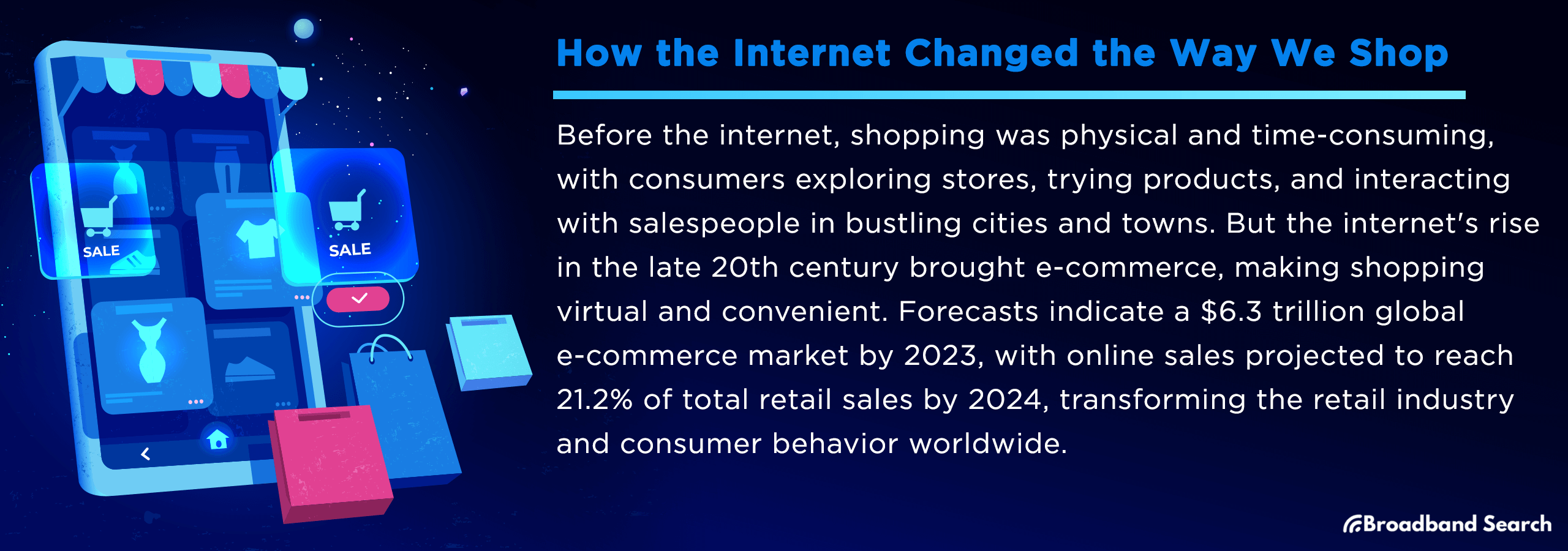E-commerce has shifted shopping from aisles to apps. In minutes, people can compare prices, check reviews, and buy from anywhere. By 2025, global e-commerce sales are projected to reach $7.4 trillion, making up nearly 24% of all retail. Below is a concise snapshot of how the internet reshaped shopping—and what the latest numbers say about where it’s headed.
Key Takeaways: Online Shopping Statistics
- E-commerce growth: Grown from less than 5% of retail sales in 2010 to an expected 20.5% in 2025.
- U.S. e-commerce share (Q2 2025): Makes up about 16.3% of retail.
- Physical stores: Brick-and-mortar stores still make up about 80% of global retail sales.
- Mobile shopping: Over 70% of all e-commerce sales are made on mobile devices.
- AI influence: Artificial Intelligence is reshaping the shopping experience, influencing over half of all purchase decisions in the U.S.
The Dawn of E-commerce
E-commerce is the buying and selling of goods and services online. It also covers the transfer of money and data needed to complete these transactions. This model represents a huge change from traditional business, using the internet to make sales happen almost instantly, often across great distances.
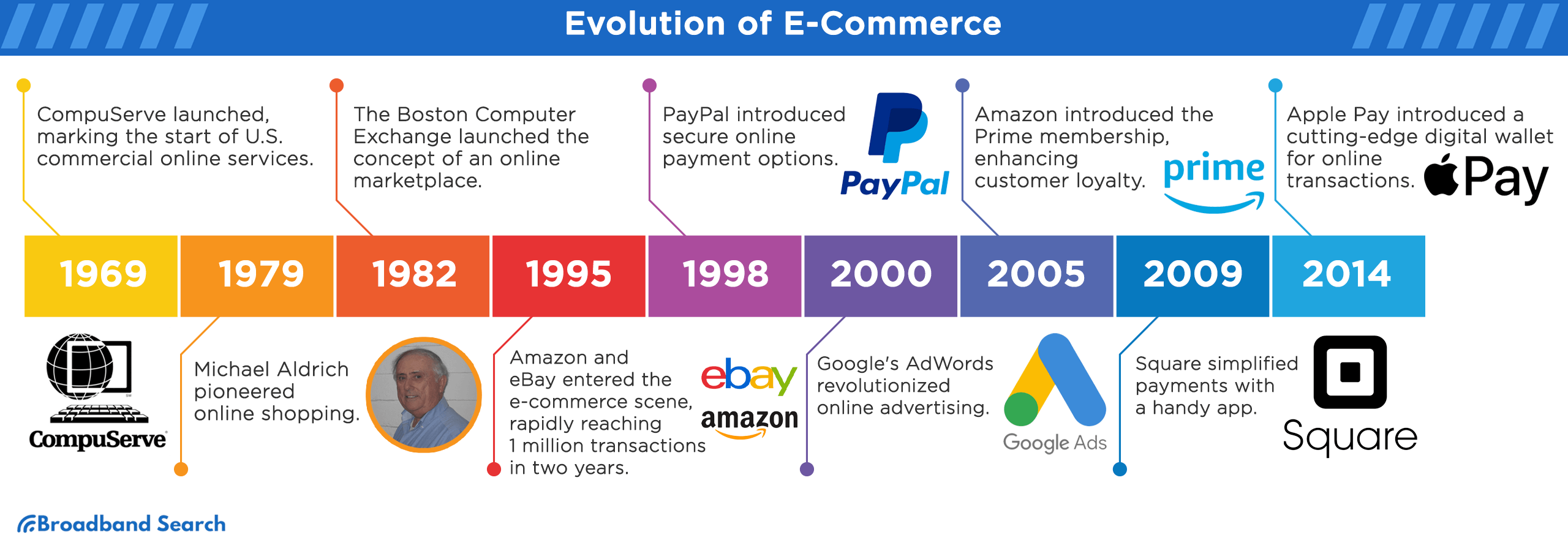
Evolution of E-Commerce
- 1969: CompuServe launches, enabling early online services.
- 1979: Michael Aldrich demonstrates connected shoppingvia telephone lines.
- 1982: Boston Computer Exchange becomes an early online marketplaces.
- 1995: Amazon and eBay launch; within two years, they surpass one million transactions.
- 1998: PayPal introduces online payments.
- 2000: Google AdWords reshapes digital advertising.
- 2005: Amazon Prime launches, accelerating delivery expectations.
- 2009: Square simplifies mobile payments.
- 2014: Apple Pay popularizes digital wallets.
Leading Online Retailers in the U.S.
| Retailer | Monthly Visitors |
|---|---|
| Amazon | 2.67 B |
| eBay | 546 M |
| Walmart | 516 M |
| Craigslist | 468 M |
| Target | 201 M |
| Etsy | 195 M |
| Best Buy | 192 M |
| Macy’s | 165 M |
| Home Depot | 342 M |
| Wish | 112 M |
Online Shopping Trends 2025
Online shopping continues to reshape consumer behavior, with mobile purchases now dominating the e-commerce landscape. The shift toward digital retail has been steady but dramatic, reshaping how and where people spend money.
Mobile vs. Desktop Shopping Share
The convenience of shopping from anywhere has made mobile phones the primary device for online purchases. According to CreditCardProcessing.com, more than 70% of e-commerce sales now happen on mobile devices. Businesses must have mobile-friendly websites and apps to meet customers where they are.
Brick-and-Mortar Sales vs. Online Sales
Despite rapid growth of e-commerce, physical stores still hold a significant share of the retail market. The “Amazon Effect” describes how online giants have forced traditional retailers to adapt by integrating digital strategies such as in-store pickups and more engaging in-store experiences.
Brick-and-Mortar vs. Online Sales
| Year / Period | Brick-and-Mortar Share | E-Commerce Share | Source |
|---|---|---|---|
| ~2010 | ~95% | <5% | Red Stag Fulfillment |
| 2012 | ~92% | ~8% | Digital Commerce 360 |
| 2021 | ~82% | ~18-20% | Digital Commerce 360 |
| 2024 (Global) | 80.1% | 19.9% ($6.01T) | Capital One Shopping Research |
| Q2 2025 (U.S.) | ~83.7% | 16.3% | FRED – St. Louis Fed |
Top Insights for Brick-and-Mortar vs. Online Sales:
- E-commerce has more than tripled its market share in the last decade.
- Brick-and-mortar stores still dominate retail.
- Online sales grew 15.7% (2022-2024) vs. 1% for physical stores.
- U.S. e-commerce share is stabilizing at ~16.3% in 2025.
Statistics Highlighting the Growth of Online Shopping
Social media and e-commerce have merged, creating on-platform shopping trends worldwide.
| Country | On-Platform Social Commerce | Social Commerce |
|---|---|---|
| Thailand | 62% | 88% |
| India | 50% | 86% |
| UAE | 49% | 86% |
| China | 52% | 84% |
| Colombia | 46% | 80% |
| Indonesia | 42% | 79% |
| Mexico | 43% | 76% |
| Brazil | 42% | 72% |
| Argentina | 41% | 68% |
| South Africa | 42% | 68% |
| United States | 32% | 63% |
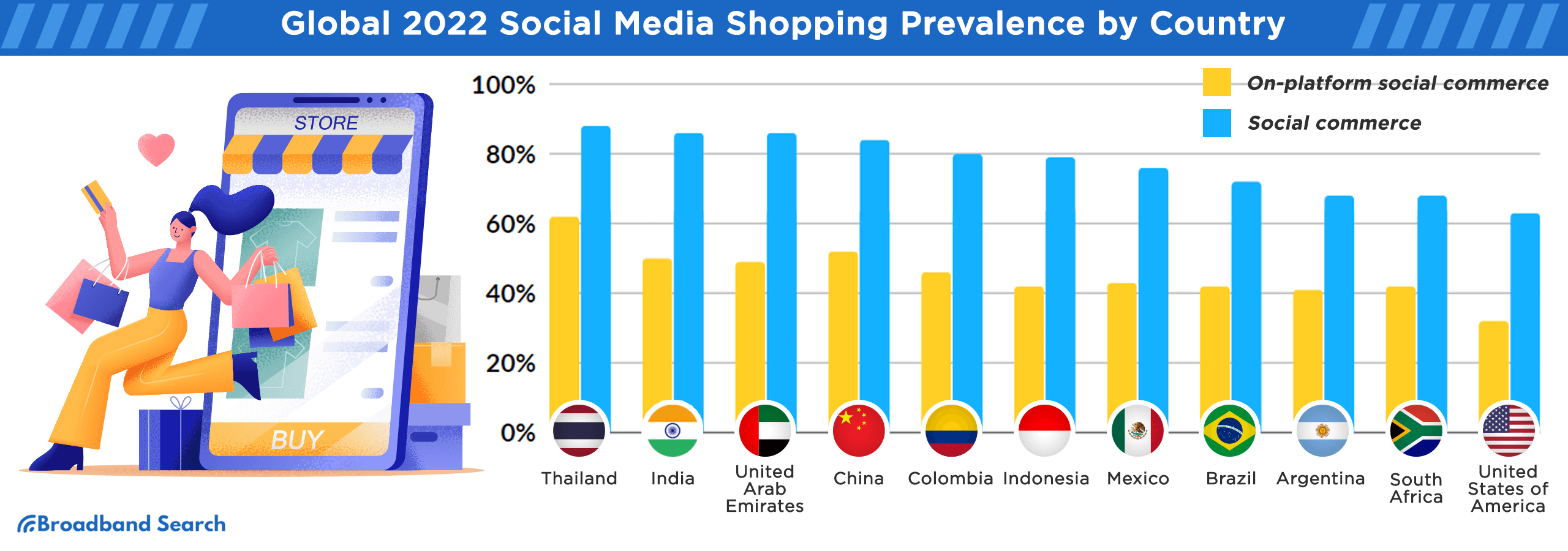
Age Groups Most Active in Online Shopping:
| Age Group | Share Reporting Online Purchases | Source | |
|---|---|---|---|
| Gen Z (18–25) | 52% | WebFX | |
| Millennials (26–41) | 58% | FitSmallBusiness | |
| Gen X (42–57) | 51% | WebFX | |
| Baby Boomers (58–76) | 45% | WebFX |
Gender-based Online Shopping Habits:
- Men: Prefer smartphones, buy quickly, prioritize price.
- Women: Often use desktop, browse more, focus on best deals.
US' Most Popular Online Shopping Categories
The digital marketplace in the US showcases a diverse array of shopping categories, each reflecting the evolving needs and preferences of consumers. From daily essentials to luxury items, online shopping has transformed the way Americans access and purchase products.
- Fashion: Dominating the online retail space with a staggering $990 billion.
- Electronics: A close second, with consumers spending $910 billion on gadgets and tech products.
- Toys, Hobby, and DIY: A testament to the nation's creativity and leisure activities, this category raked in $780 billion.
- Beauty, Health, Personal, and Household Care: Catering to self-care and daily needs, this sector generated $400 billion.
- Food: The convenience of online grocery and gourmet shopping brought in $350 billion.
Reasons Shoppers Leave Their Online Carts Unpurchased
Online shopping offers unparalleled convenience, but there are several factors that can deter a shopper from completing a purchase. Understanding these reasons is crucial for businesses to optimize their user experience and reduce cart abandonment rates.
- Additional Charges (Shipping, Taxes, Additional Fees) - 48% of shoppers abandon carts due to unexpected costs like shipping and taxes, which can erode trust.
- Mandatory Account Creation - 24% of customers prefer not to be forced into creating an account, desiring a hassle-free purchase instead.
- Prolonged Delivery Times - 22% of buyers opt out if delivery times are too extended, given the importance of quick shipping in today's fast-paced world.
- Concerns About Site's Credit Card Security - Trust issues related to credit card security deter 18% of potential shoppers.
- Complex Payment Procedure - 17% of shoppers drop out because of a complicated checkout process.
Top Social Media Platforms for Online Shopping
Social media platforms have evolved beyond networking and entertainment, now playing a significant role in e-commerce. The integration of shopping features has transformed these platforms into vibrant marketplaces.
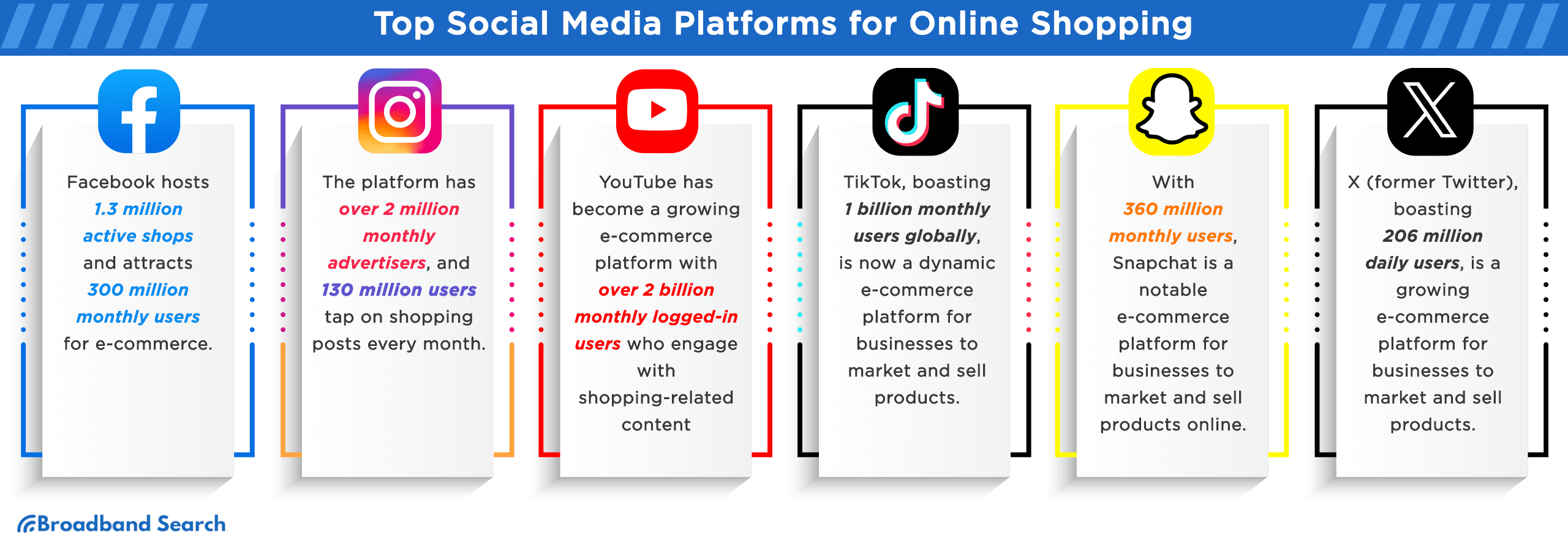
- Facebook: With its vast user base, Facebook has become a major player in the e-commerce space, offering a range of shopping features and integrations.
- Instagram: Leveraging visual appeal, Instagram provides a seamless shopping experience with shoppable posts and stories.
- YouTube: As the leading video platform, YouTube offers various advertising and shopping integrations, making it a potent tool for e-commerce.
- TikTok: The short-video platform has quickly embraced e-commerce with features that allow users to shop directly from videos.
- SnapChat: With its younger demographic, SnapChat offers unique shopping experiences integrated within its platform.
- Twitter: Though primarily a microblogging platform, Twitter has ventured into the e-commerce domain with various shopping features and partnerships.
Leading Online Retailers in the U.S.
From giants offering everything under the sun to niche sites specializing in handcrafted goods, here's a snapshot of the top online retailers dominating the American digital marketplace in terms of visitor traffic and offerings.
- Amazon (Monthly visitors: 2.73 billion): The world's top online marketplace, Amazon offers everything from books and electronics to fashion and tools. With Amazon Prime, U.S. shoppers benefit from expedited delivery services.
- eBay (Monthly visitors: 855.82 million): Dominating various categories, eBay provides a platform for auctions, brand sales, and verified sellers. Many items also come with free shipping.
- Walmart (Monthly visitors: 468.96 million): Catering to diverse needs, Walmart online offers electronics, baby items, fashion, and more. The added perk of a Walmart credit card provides additional savings for U.S. consumers.
- Craigslist (Monthly visitors: 342.56 million): A broad platform, Craigslist encompasses everything from electronics to adult services, making it a diverse online marketplace.
- Target (Monthly visitors: 258.34 million): As the U.S.'s second-largest department store, Target boasts a product range from fashion to electronics. Their RedCard further solidifies their presence in the financial sector.
- Etsy (Monthly visitors: 266.31 million): Specializing in handmade and vintage items, Etsy provides a unique platform for artisans to sell products ranging from art to beauty goods.
- Best Buy (Monthly visitors: 192.70 million): Predominantly an electronics retailer, Best Buy also offers a range of products including appliances and fitness equipment.
- Macy’s (Monthly visitors: 165.29 million): Offering a vast collection from fashion to home decor, Macy's has also ventured into the financial world with its proprietary credit card.
- Home Depot (Monthly visitors: 147.15 million): The leading home improvement retailer in the U.S., Home Depot's online store complements its widespread physical presence across North America.
- Wish (Monthly visitors: 111.62 million): Primarily a mobile marketplace, Wish enables businesses to sell directly to consumers, focusing on electronics, beauty, and home decor.
Additional Key E-Commerce Statistics 2023
These additional statistics from 2023 provide a deeper insight into the ever-evolving e-commerce landscape. From global shopper counts to platform-specific data, the figures highlight the rapid growth, extensive reach, and significant impact of online shopping in today's digital era.
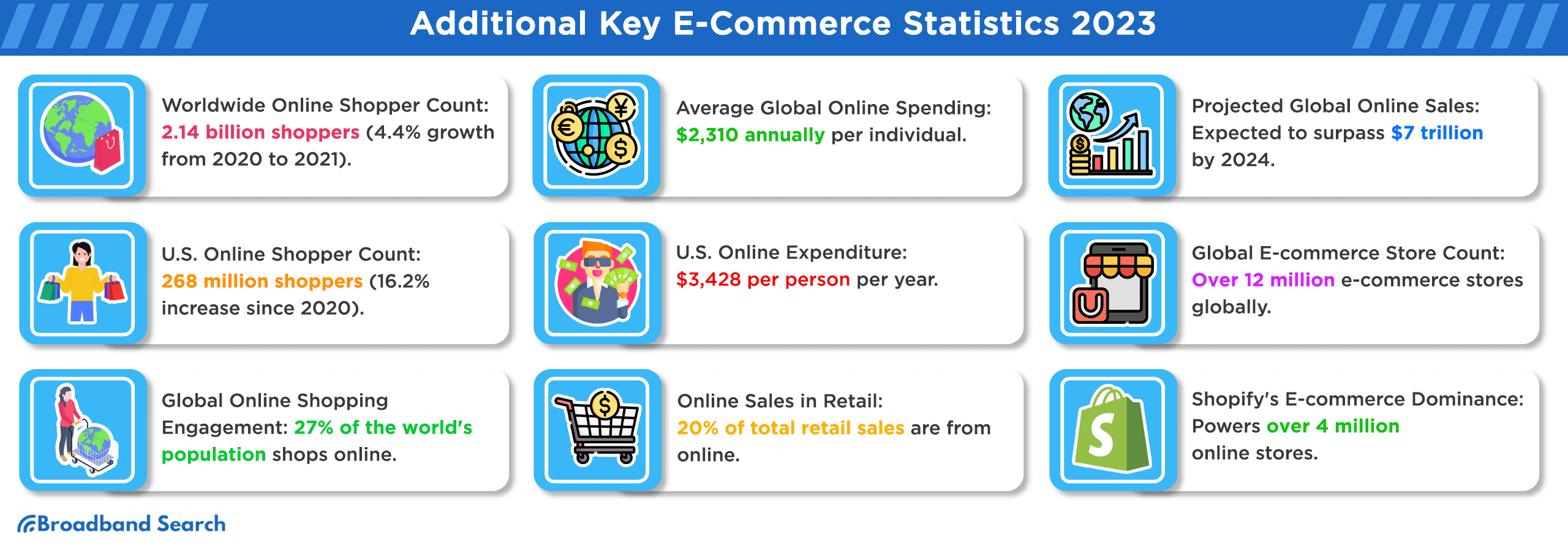
- Worldwide Online Shopper Count: The digital consumer base has witnessed significant expansion with a count of 2.14 billion online shoppers. This signifies a commendable growth rate of 4.4% in just a year, from 2020 to 2021. The surge underlines the global acceptance and trust in e-commerce platforms.
- U.S. Online Shopper Count: The United States, being a major hub for e-commerce, boasts an online shopper population of 268 million. This represents an impressive uptick of 16.2% since 2020, underscoring the nation's increasing reliance on digital shopping avenues.
- Global Online Shopping Engagement: Highlighting the vast reach of e-commerce, 27% of the world's population now engages in online shopping. This figure emphasizes the global shift towards digital shopping platforms.
- U.S. Residents & Online Shopping: Delving into national trends, a significant 70% of U.S. residents are now frequent online shoppers. This statistic showcases the penetration and acceptance of e-commerce within the country.
- Average Global Online Spending: On a global scale, the average individual spends approximately $2,310 annually on online purchases. This figure encapsulates the global consumer's trust and dependency on online markets.
- U.S. Online Expenditure: Zooming into the U.S., the average American splurges about $3,428 per person on online shopping every year. This higher average indicates the nation's strong purchasing power and affinity for e-commerce.
- Online Sales in Retail: In the grand retail landscape, online sales now account for a whopping 20% of total retail sales. This highlights the growing dominance of e-commerce in the retail sector.
- Projected Global Online Sales: Looking ahead, the momentum of e-commerce shows no signs of slowing down. By 2024, the global online sales figures are projected to cross the monumental mark of $7 trillion.
- Global E-commerce Store Count: The digital marketplace is bustling with over 12 million e-commerce stores operating globally. This vast number exemplifies the immense competition and variety available to online shoppers.
- Shopify's E-commerce Dominance: A notable player in the e-commerce platform industry, Shopify, now powers over 4 million online stores. This statistic attests to Shopify's widespread adoption and its pivotal role in facilitating online businesses.
Evolving Patterns in Future E-Commerce
The future of e-commerce is marked by rapid technological advancements and changing consumer behaviors. As voice-activated shopping gains traction and social media platforms evolve into e-commerce hubs, businesses are leveraging machine learning to offer personalized shopping experiences. These emerging trends underscore the dynamic nature of online retail and the need for businesses to adapt and innovate continuously.
- Voice-Activated Tech Paving the Way for Streamlined Commerce: The use of smart devices like Alexa for shopping is rising, especially among millennials. Nearly 50% have used voice technology for online purchases. By 2022, voice shopping in the U.S. is predicted to reach $40 billion.
- Social Media Shopping: The New Extension of E-Commerce Platforms: Platforms like Instagram and Pinterest are now e-commerce hubs. Over half of Instagram users search for products, and AR features on these platforms can significantly influence buying decisions.
- Leveraging Machine Learning for Tailored Online Shopping Journeys: Modern shoppers seek personalized experiences. Utilizing AI and machine learning, brands can offer tailored recommendations, leading to increased sales. Investments in e-commerce personalization can yield significant returns, emphasizing the blend of technology and human insights for market optimization.
Essential Tips for Modern Online Shopping
- Ensure Website Security: Check for HTTPS and trust badges.
- Use Price Comparison Tools: Tools like Honey and CamelCamelCamel help find the best prices.
- Read Product Reviews & Verify Sellers: Ensure quality and reliability.
- Understand Return & Exchange Policies: Know the process and costs before buying.
- Opt for Secure Payment Methods: Prefer credit cards or trusted gateways.
The Online Shopping Evolution is Just Getting Started
The internet has shifted shopping from physical aisles to digital catalogs. Convenience, global access, and instant price comparison are huge benefits, but cybersecurity and less personal experience are challenges. Balancing convenience with data safety is essential. Innovations like AI and augmented reality will continue to redefine e-commerce.
FAQ
How much of retail shopping is online now?
In 2025, e-commerce makes up about 20.5% of all global retail sales, representing a multi-trillion-dollar shift in consumer behavior.
When did online shopping really take off?
It started in the early 2000s, but the 2010s made it mainstream. The pandemic (2020–2022) pushed adoption into overdrive, making online shopping a default habit across all demographics.
What’s happening to physical retail stores?
E-commerce growth keeps outpacing in-store sales. To survive, most retailers are embracing omnichannel models like curbside pickup, same-day delivery, and unified online/offline returns.
How big is the e-commerce market in 2025?
This year, global e-commerce is expected to hit $6.86 trillion, capturing roughly 20–25% of total retail worldwide.
Is mobile shopping now the norm?
Yes. By 2025, 59% of retail e-commerce sales (≈ $4.01 trillion) come from mobile devices.
How is AI changing the way we shop online?
AI is everywhere in e-commerce — powering:
- Personalized product recommendations
- Chatbots & voice assistants
- Virtual try-ons and visual search
- Predictive pricing & inventory tools
It’s making shopping faster, smarter, and more tailored to individual behavior.
What’s the smartest way to score online deals?
Shoppers are stacking tools to save more, including:
- Price trackers like CamelCamelCamel
- Coupon finders like Honey
- Cashback apps like Rakuten
- Retail search engines (Amazon, Walmart, Google Shopping)
Pro tip: Use at least two tools at once (e.g., Honey + a cashback site) for maximum savings.

